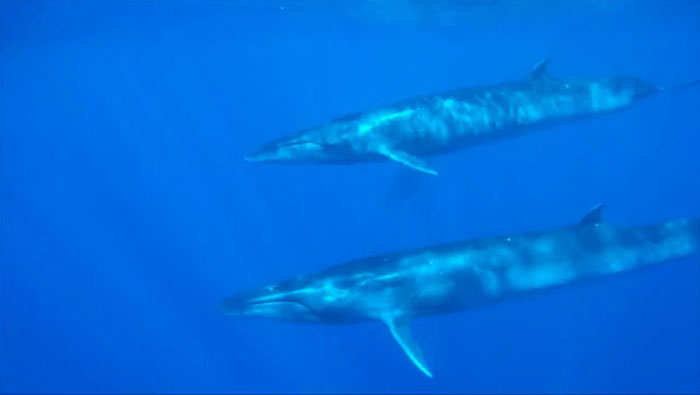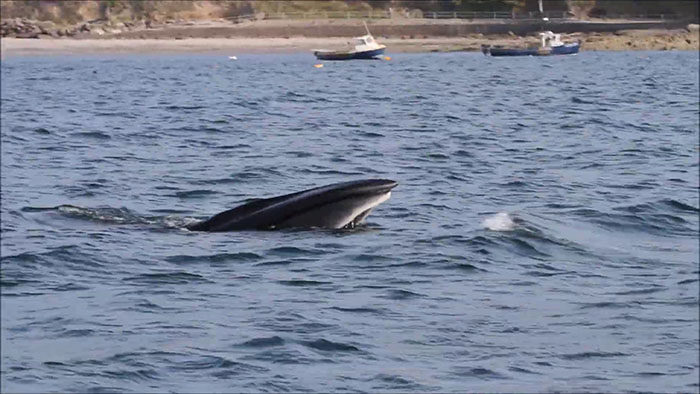We, humans, may be at the top of this world’s food chain due to our intellect, but we sadly often forget that we’re not the only ones living here and that this planet is supposed to be shared with everyone else on it.
For example, even though whales are some of the most majestic animals on our planet, whalers in the past hunted them so much that many of them became endangered and were forced to abandon their ancestral waters, like the sei whales in Argentina. And yet, time and time again, life still finds a way. Just recently, a few members of this species started appearing back home, where they were absent for nearly a whole century. Scroll down to read the full story!
More info: Good News Network
Whales are some of the biggest and most majestic animals on Earth, but that didn’t stop humans from driving them close to extinction

Image credits: WAspearfisherman (YouTube)
The massive amount of whaling that came with World War I left many whale species endangered and forced into hiding before regulations were put in place to protect them
Before 1946, when the International Convention for the Regulation of Whaling finally established rules to protect whales from being overhunted, most of these majestic animals were in grave danger of extinction. And yet, it took nearly 30 more years for some species, like the sei whales, to get any meaningful protection from the rules set by the International Whaling Commission.
While the consequences of the whaling spree that occurred since World War I can still be felt to this day, more and more recent whale sightings in places where they were absent for the longest time have proven that the regulations had a positive impact and were quite effective.

Image credits: WAspearfisherman (YouTube)
Now, nearly 100 years later, people are rejoicing because of the increasing whale sightings in their ancestral waters, with sei whales returning to Argentina being the latest news
One of the latest occurrences happened in Argentina, where just last month, sei whales, absent from the region for nearly a whole century, were noticed returning to their ancestral waters. “It nearly took 100 years for their population to reach a level where people could notice their presence,” said Biologist and Marine Ecosystem Researcher Mariano Coscarella when he was interviewed by Reuters, adding that these whales reproduce only every two or three years.
This news brought smiles to many faces. However, while most people in the comments section were happy to hear that the whales are finally doing better, some were quite concerned that it may not be long before whaling comes back to fashion and the cycle repeats itself once again.


While sei whales are steadily recovering, they’re still endangered and need to be protected, with their global population estimated at around 50,000
The return of these baleen whale family members is definitely a wonderful sight, but while these animals do indeed seem to be doing better, they’re still quite far away from being delisted from the IUCN Red List of Threatened Species, with their global population currently estimated at only around 50,000.
Fortunately, that number is currently on the rise, and there are many out there who give their all to ensure that the ocean and all its inhabitants are protected and can thrive as much as possible. One of these people is Carissa Cabrera, a marine conservationist and biologist who works with nonprofits and community coalitions to safeguard ocean health and ecosystems.

Image credits: WAspearfisherman (YouTube)
Baleen whales, like sei whales, are not only intelligent and sentient beings but also long-lived reservoirs of blue carbon and are incredibly important for a healthy planet
“The whaling industry decimated populations of large whales around the world. Now, 50 years after a moratorium on whaling by the International Whaling Commission, we are seeing long-lived whale populations bounce back,” began Carissa when Bored Panda reached out to her for a few questions regarding this topic. The expert added that while environmental changes might play a role in these animals returning to their former habitats, it is still mostly due to regulations that protect whales from being hunted.
While many people love and want to protect animals like baleen whales because they are charismatic, intelligent, and sentient, most don’t know that they’re also an incredibly powerful climate solution. “They are long-lived reservoirs of blue carbon, and when they die, they continue to sustain marine life as food. In terms of climate solutions, one large whale, like a sei whale, stores more carbon than 1,000+ trees! Protecting whales is not just needed for a healthy ocean but a healthy planet,” explained the expert.

However, while sei whales are doing better, some whale species are still being hunted, and it is in our hands to vote and make a change
However, not all whale species are doing as well as the sei whales. “Some whales continue to teeter on the edge of extinction and face direct harm from industries driven by profits,” Carissa said, giving an example of how, just last week, the Icelandic government granted a hunting license to kill over 100 fin whales, which are another member of the baleen whale family.
“The most effective way to protect species from harm is through policy and measures to protect the habitat and environment the species rely on to stay healthy. Each of us as individuals plays a role in advocating for that through signing petitions, supporting wildlife conservation NGOs (like WWF), and playing a role in demanding protections from our government through voting.”

Image credits: WAspearfisherman (YouTube)

Image credits: WAspearfisherman (YouTube)
If we look at the whole picture, there are many things to be happy about. We now have 26 countries in the alliance against deep sea mining, and many nations around the world are collaborating to protect the global ocean or high seas through the High Seas Treaty. “The U.S. recently released an Ocean Justice Strategy to support coastal communities across the nation, and millions of dollars in federal funding are going to restoration as we speak, thanks to the Inflation Reduction Act,” concluded Carissa.
But in the end, there are still long roads ahead until we can confidently say that the world’s oceans are doing well. While we should definitely celebrate every win, such as the increase in whale population, we must also be wary that there will always be people trying to use every single situation for their personal gain, regardless of how it affects anyone else. Therefore, don’t forget that your voice and actions matter, and when it comes to saving our planet, remember to make use of them.
What did you think about this story? Have you ever had a chance to observe a whale up close? Share your thoughts in the comments below!
The commenters were happy about the good news, but they were worried that once the information spreads, people might start hunting these whales all over again








